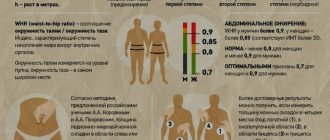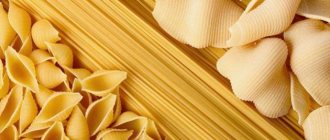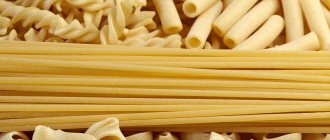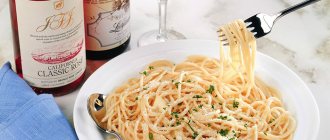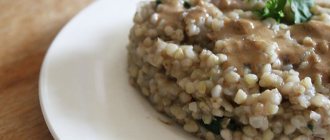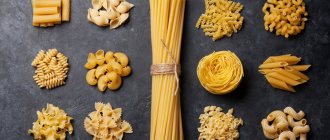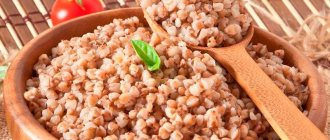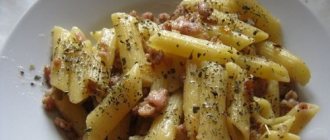What is healthier, pasta or buckwheat?
Nutrition is at the core of human health, which is why it is so important to pay attention to the right food choices .
What to give preference to, everyone decides for themselves. The diet is determined by taste priorities, the presence of chronic diseases, the desire to lose weight or gain muscle mass. There are a number of products that are present in the diet of any person. These include pasta and buckwheat. Let's look at the pros and cons of these popular products and find out which one is healthier.
Pasta diet
It sounds strange, but it is very effective and efficient - in 7 days you can get rid of 3 - 5 kg of excess weight. The pasta diet comes from Italy, the birthplace of the main product. According to stories, it is this type of nutrition that helps maintain the beauty and slimness of Sophia Loren herself. It is believed that you can follow a pasta diet for no more than 30 days in a row, after which you need to take a break for 3 months.
Rules for the pasta diet:
- do not “abuse” the product, but combine it with vegetable salads, fish and other components of a healthy diet;
- eat frequently, but in small doses - at least 4 times a day;
- drink a lot of water - at least 1.5 liters per day;
- give up any fatty foods and dishes, including butter, dairy cream, fatty meats and fish;
- exclude sweets and pastries from the menu.
To make it easier to plan your diet, you can take one day’s menu as a basis:
- morning – any fruit salad with natural yoghurt and honey + 200 ml of tea without sugar;
- day – boiled pasta with bell peppers and carrots (you can prepare a salad with a small amount of vegetable oil);
- afternoon snack – 2 fresh apples or 250 juice from them;
- evening – stewed vegetables + boiled chicken fillet.
It is important to follow the basic rule of the pasta diet - the portion should not exceed 250 g. If the feeling of hunger is too tiring, then snacks are allowed, for which nuts, any fruit, low-fat kefir, rye bread crackers are suitable.
Watch this video about the pasta diet:
Characteristics of pasta and buckwheat
Pasta is the general name for a large number of varieties of pasta. The homeland of pasta is Italy , and it is from there that the recipe for their preparation came. Pasta is made from flour, most often wheat, and water. Pasta made from durum wheat, which contains a high percentage of gluten and a minimum of starch, is considered healthy.
Buckwheat is a natural product , available for consumption in boiled and raw form (steamed cereal). To prepare porridges and soups, whole grain cereals, kernels, and crushed cereals are used. A crumbly porridge is prepared from the core by adding butter or milk. Crushed grains produce a viscous porridge, which is prepared in water and used in medical nutrition.
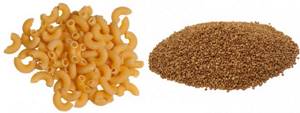
What do you cook dog grains with?
It is advisable to cook in water, since if you do this using meat broth, the shelf life will sharply decrease and the fat content will increase. You cannot use milk; it will be an additional burden for the animal’s body. Give together with protein and fiber: with meat and vegetables.
The cooked product is stored in the refrigerator for no more than two days and meat products and vegetables are added just before feeding.
Remove the meat from the bones and cut into small pieces. Added raw or cooked. It is best to use beef, turkey and rabbit, chicken (with caution). These types of meat are perfect for dietary nutrition.
Offal occupies a special place in a dog's diet. They must be included in the diet, choosing beef and rabbit. When choosing meat products, you should give preference to those that have veins, sinews and any other connective tissue. But not fat, of course.
Often a mixture of cereals is used, which are mixed immediately after cooking or before serving. But they must be cooked strictly separately.
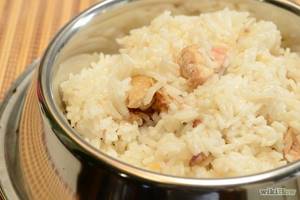
Useful qualities of pasta
There is an opinion about pasta that it is of little use and even harmful, leading to excess weight. This opinion is wrong; in fact, pasta has many useful qualities:
- Rich in carbohydrates, which fill the body with energy.
- They contain a lot of useful minerals and vitamins: iron, magnesium, phosphorus, vitamins B and E.
- Low sodium , which provokes aging of the body.
- No cholesterol.
- of fiber in the composition promotes digestion and the removal of toxins and heavy metal salts.
- Contains the amino acid tryptophan , which ensures proper sleep.
- Low calorie content - 100 g of cooked pasta contains about 100 kcal (about the same as 100 g of buckwheat without oil and salt).
The benefit of pasta is the ease of preparation and the variety of dishes that can be prepared from it in combination with sauces, vegetables and meat.

Useful qualities of buckwheat
The benefits of buckwheat have been known since ancient times. In addition to being healthy, it is also a tasty product, simple and quick to prepare. The following qualities speak in favor of buckwheat:
- Many useful substances needed by the body: iron, calcium, potassium, folic acid, vitamin E, other trace elements and amino acids.
- Prevention of cancer and hepatitis, hematopoietic function.
- Beneficial effects on the body of people prone to hypertension, diabetes and atherosclerosis.
- Ecological purity - buckwheat is not susceptible to pests, so no chemicals are used in its cultivation.
- Low carbohydrate content and leader in protein content among other cereals.
- Long shelf life due to the presence of phenol and phenolic compounds in the antioxidant composition.
- Extremely rare cases of allergies.
An impressive range of beneficial qualities explains the presence of buckwheat in the list of frequently consumed foods. Its high protein content makes it one of the main dishes of Lenten cuisine, when meat consumption is limited. Buckwheat is necessarily included in the diet of athletes as a natural energy drink that fills muscles with strength.
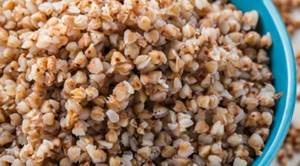
Contraindications
No matter how high the benefits of a particular product, there are always limitations to its use. Even a healthy product can be harmful if it is improperly prepared or served in combination with incompatible products .
As for pasta, the only danger is its consumption in excessive quantities . The large amount of energy generated during the digestion of pasta must be fully utilized. Therefore, with sedentary work and a sedentary lifestyle, addiction to this product will lead to excess weight gain.
Which ones should you choose when losing weight?
If a person is on a diet, but at the same time wants to eat a nutritious and varied diet, then he may well include pasta dishes in the menu. There is a wide range of this product on the market, so it’s worth learning how to navigate and choose the best option.
Durum varieties
They are certainly beneficial for the body in general and for weight loss in particular. When properly consumed in small portions, durum pasta will satisfy hunger for a long time, diversify the diet and increase performance and endurance. It is this product that gives those losing weight the necessary energy, so they can lead an active lifestyle and play sports.
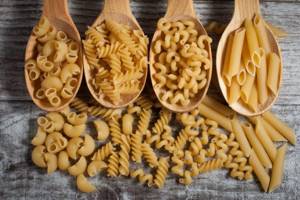
How to choose hard pasta: you must first pay attention to the appearance of the product - the “right” one will be yellowish and smooth to the touch.
From spelled
This is a product that contains flour from the hard shell of grains - this is what is called spelled. It has a lot of useful properties - cleanses the intestines, normalizes the functioning of the entire gastrointestinal tract, does not increase blood sugar levels, and helps reduce the amount of “bad” cholesterol. But when losing weight, spelled pasta is valued for its low calorie content and long digestibility - it quickly fills you up and satisfies hunger for a long time.
Such pasta is prepared according to the classic method - boiled until almost done within 5 - 7 minutes from the moment of boiling. When losing weight, they can be consumed with vegetable stews, fermented milk sauces and seafood.

Whole grains
It is believed that such pasta is low in calories, high in amino acids and vitamins with microelements. Dietitians are confident that the benefits of whole grain products are too exaggerated - when compared, both the glycemic index and calorie content are not very different from regular durum pasta.
In addition, the taste of a dish made from such a product is quite specific and is described by consumers from “tasty and liked it” to “impossible to even swallow.”
Whole grain pasta is prepared using the standard method and consumed with all ingredients allowed on the diet. It is recommended to choose noodles or spaghetti - they will be more useful due to pressing during production.

Buckwheat
A very specific taste, but a very useful product for weight loss. When eating buckwheat pasta:
- intestinal microflora is normalized;
- constipation and diarrhea disappear;
- metabolic processes are accelerated;
- hunger is satisfied for a long time;
- appetite decreases.
The product contains various vitamins and microelements; nutritionists allow their daily use in the amount of 200 g. They can be supplemented with low-fat sauces, seafood, mushrooms, but in this case it is necessary to reduce the portion, since the finished dish will have a high calorie content.
To learn how to choose healthy pasta, watch this video:
Recommendations for use
When choosing the “right” pasta, you need to carefully read the label and look for a message that it is made from durum wheat . When buying original Italian pasta, you don’t have to worry about this - in Italy, all pasta is made exclusively from this flour.
It is more useful to eat pasta as an independent product , and not as a side dish. You can add butter or olive oil. Pasta goes well with vegetables, cheese, lean meat and seafood. It is advisable to exclude fatty meat sauces and mayonnaise - they are the source of excess calories.
When purchasing buckwheat, you should pay attention to its color . It is preferable to purchase light brown cereals - this means that they are not overcooked and have retained all the useful elements. Green buckwheat is also useful; it is good to add to soups.
Pre-soaked or sprouted green buckwheat is used as food by raw food enthusiasts and athletes . One day a week, spent exclusively on buckwheat, will unload and cleanse the body of toxins.
“Buckwheat, pasta and canned food”: eight recipes for those who are self-isolating
During self-isolation or quarantine, many of those stuck at home are forced to cook several times a day.
Dishes made from shelf-stable foods purchased in advance should be at the same time interesting, satisfying, easy to prepare and at least conditionally dietary, since there is much less physical activity in life.
Guryev porridge with canned fruits
Per 100 g: 260 kcal, 7.5 g protein, 12 g fat, 30 g carbohydrates
What do you need:
- 4 tbsp. l. semolina
- 3 tbsp. l. Sahara
- 1 chicken egg
- 100 ml milk
- 2 tsp. melted butter
- 2 tbsp. l. almonds
- ½ can of any canned fruit
- vanillin to taste
How to cook:
Add sugar and vanillin to boiling milk. After this, gradually add semolina and, stirring, cook for 10 minutes.
Put butter and raw eggs into the cooked porridge, mix everything well and place in a frying pan, previously greased with butter, sprinkle with sugar and place in a hot oven.
When a light brown crust forms, the porridge is ready. When serving, the porridge can be decorated with canned fruit, topped with sweet sauce and sprinkled with toasted almonds.
Tuna and corn salad
Per 100 g: 104.6 kcal. Protein, 7.7 g fat, 3.6 g protein, 10.3 g carbohydrates
What do you need:
- 1 can of canned tuna (preferably in its own juice)
- 1 can canned sweet corn
- 1 carrot
- 1 onion
- 6 boiled eggs
- 4 tbsp. l. vegetable oil
- 2-3 cloves of garlic a bunch of parsley/dill salt to taste
How to cook:
Peel and wash the onions and carrots. Cut into strips. Heat a frying pan, pour in vegetable oil. Add onions and carrots. Fry over medium heat for 2-3 minutes. Remove from heat and cool.
Open canned fish. Drain half the liquid and mash with a fork. Peel the garlic and chop it. Wash the greens and chop finely.
Peel the chicken eggs and chop finely. Open a can of canned corn and drain the liquid. Place all ingredients in a bowl (set aside some of the corn and herbs for decoration). Add salt if desired.
Mix the prepared canned fish with canned corn, fried carrots and onions, chopped eggs, and season with oil.
Canned pink salmon cutlets with rice
Per 100 g: 342 kcal, 12.6 g protein, 5.1 g fat, 62 g carbohydrates
What do you need:
- 1 can of canned fish (pink salmon)
- 1 carrot
- glass of cooked rice
- 1 chicken egg
- 150 g flour
- vegetable
- frying oil
How to cook:
Remove the bones from canned pink salmon and mash the fish with a fork.
In a deep bowl, mix fish, carrots fried in vegetable oil and boiled rice.
Add a raw egg.
Mix, form small cutlets, roll in flour.
Place the cutlets in a preheated frying pan with vegetable oil. Fry them until golden brown on both sides.
Soup with beans and chicken in Georgian style
Per 100 g: 198 kcal, 17 g protein, 4.9 g fat, 22 g carbohydrates
What do you need:
- 200 g chicken breast canned red beans
- 2 sweet peppers
- 1 carrot
- 4 tbsp. l. tomato paste salt
- 1 tbsp. l. vegetable oil
How to cook:
Cut the chicken breast into small pieces.
Heat vegetable oil in a frying pan, add chicken, fry for 4-5 minutes.
Place a pan of water on the fire.
Wash the bell pepper, remove the seeds, and cut into strips.
Wash the carrots, peel them, cut into strips or chop on a coarse grater. Add vegetables to chicken.
Add tomato paste and beans from a can along with the liquid, add salt and mix. Simmer, covered, for 7-10 minutes.
Add salt to boiling water or dissolve vegetable or chicken stock cubes. Place the stewed vegetables and chicken in the water, stir, and bring to a boil.
Perlotto
Per 100 g: 81.3 kcal, 7.2 g protein, 1.1 g fat, 10.7 g carbohydrates
What do you need:
- 185 g pearl barley
- 350 g chicken fillet
- 1 medium sized carrot
- 1 large onion
- 0.5 l broth
- sunflower oil,
- salt,
- pepper to taste
How to cook:
Rinse the barley and let it drain in a colander for 15 minutes. Peel the onion and chop it as finely as possible.
Peel the carrots and cut into small pieces. Fry carrots and onions in a frying pan until golden brown.
Cut the chicken fillet into small pieces. Add fillet to fried vegetables.
Fry everything together for five minutes, stirring constantly. Add the washed barley to the chicken, carrot and onion dressing.
Fry everything together for three minutes, remembering to stir continuously so that the pearl barley does not burn.
Season with broth, salt and pepper to taste and leave to simmer on low heat for 50 minutes.
"Red" buckwheat
Per 100 g: 237.7 kcal, 7.3 g protein, 6.8 g fat, 39.2 g carbohydrates
What do you need:
- 250 g buckwheat
- small roasted beets
- 1 onion
- 3 cloves garlic
- 1 tbsp. l. lemon juice
- 2 tbsp. l. vegetable oil
- spices (salt, pepper) to taste
How to cook:
Peel the baked beets, grate them on a fine grater or chop them in a blender.
Fry the buckwheat in a dry frying pan for 4-5 minutes until fragrant.
Chop the onion and garlic, sauté in vegetable oil in a saucepan until translucent, add buckwheat. Pour boiling water in a ratio of 1:2. Close the lid, put on low heat, cook until done.
Add beets to the prepared buckwheat. Add salt, pepper, lemon juice and heat over heat for a couple more minutes.
Serve with sour cream, herbs and crushed walnuts.
No-bake peach cheesecake
Per 100 g: 270 kcal, 10.1 g protein, 14.2 g fat, 24.7 g carbohydrates
What do you need:
- vanillin to taste
- 100 g sugar
- 30 g gelatin
- 2 cans canned peaches
- 200 g of Yubileiny cookies
- 200 g butter
- 400 g cottage cheese
- 200 ml 30% cream
How to cook:
Dilute 15 g of gelatin in the amount of water indicated on the package, leave to swell for 30 minutes. Drain the syrup from one can of peaches and soak the remaining gelatin in the syrup.
Crush the cookies into crumbs, mix with softened butter, mix well. Place in a mold and spread across the bottom. Place in the refrigerator.
Stir gelatin from the first glass and put on fire. Heat without bringing to a boil, stir until the gelatin is completely dissolved. Cool until warm. Beat sugar, cream and a pinch of vanilla until the sugar dissolves. Add cottage cheese, stir until smooth. Finally, stir the cooled gelatin into the curd cream.
Pour the curd cream over the base in the mold and place the cheesecake in the refrigerator for 1-2 hours to harden.
Heat the syrup with the soaked gelatin over a fire, stir until dissolved, without allowing the liquid to boil. Set aside and let cool.
Cut the peaches into slices and place on the frozen cheesecake. Carefully pour the cooled gelatin syrup over the cheesecake and place in the refrigerator for another 2-3 hours.
Oatmeal cookies with prunes and flax
Per 100 g: 364.1 kcal, 7.5 g protein, 14.3 g fat, 51 g carbohydrates
What do you need:
- 50 g butter
- 50 g sugar
- 1 chicken egg
- 75 g oat flakes
- 100 g wheat flour
- 1 tsp. baking powder
- 60 g prunes
- 10 g flax seeds
How to cook:
Melt the butter in the microwave, mix with sugar until it is partially dissolved. Add the egg, beat with a whisk.
Grind the prunes in a blender or finely chop with a knife. Add chopped prunes and flax seeds to the oil mixture. Add oatmeal. Mix.
Sift the flour and mix with baking powder. Combine all ingredients, knead the dough.
Place in a bag and refrigerate for an hour. Roll out the dough, form cookies with a glass or using molds (diameter - about 6 cm).
Place the cookies on parchment and bake in the oven at 180 degrees for 13-15 minutes until light brown.
Quarantine, provided that you feel well and have free time, can be used to your advantage if you have reliable and satisfying recipes on hand from products that do not need to be purchased daily.
Use it to eliminate boredom from your menu.
Maria Ruskova
Photo depositphotos.com
The opinion of the author may not coincide with the opinion of the editors
Conclusion
Pasta and buckwheat are traditional dishes on our table, which can be consumed in limited quantities daily . The main criteria when purchasing these products should be freshness, attractive appearance and integrity of packaging.
Pasta, when properly selected and prepared, is a universal product with virtually no contraindications. Pasta made from high-quality flour will not affect your figure and will become a source of energy and vitality. Pasta is especially useful for men whose bodies are tuned to quickly burn glucose.
Buckwheat lovers also do n’t have to worry about gaining excess weight . Buckwheat dishes can be eaten with equal benefits for breakfast, lunch and dinner. Buckwheat is a must in the diet of people who aim to gain muscle mass. At the same time, it does not provoke fat deposits and is well absorbed. This dietary product is useful for people of any age.
When choosing this or that product for yourself, weighing the advantages and disadvantages of pasta and buckwheat, you should be guided by personal preferences, while not forgetting about the correct diet and the characteristics of your own body.
Porridge and pasta - about the harm and benefits.
The porridges are different - necessary and important.
For adults, pasta and porridge are a side dish, and for children it is the main food. You can serve them not with a cutlet or sausage, but as a separate full-fledged dish.
Many children enjoy eating buckwheat porridge - just add butter to it. Millet is doing well, and semolina also has fans. And for rice with milk, with dried fruits or with apples and raisins, the children are ready to fight in the full sense of the word. And the words “I want more” sound like music to a parent’s heart.
Is porridge always our joy?
Is it necessary to insist that the baby eat porridge, which porridge is better to choose, and is it worth forcing the child to eat this dish if he doesn’t want to?
You need to offer your child porridge - every day and different ones. But you cannot insist on any of the products if the child does not want to eat them. Force-feeding and excessive pressure can achieve the opposite effect - the child will begin to experience aversion to this or that type of food, which will increase as the psychological pressure increases. The most beneficial for a child over one year old are oatmeal and buckwheat. Rice porridge, especially cooked from purified rice, has low nutritional value, but for variety it can be periodically included in the children's menu.
What is the “beauty” of oatmeal?
Oatmeal is healthy due to its high content of vitamins (B, PP, C) and microelements (for example, phosphorus). It is rich in vegetable protein and carbohydrates. In addition, it contains a lot of fiber, which helps normalize intestinal motor function. However, it contains gluten, so it is not recommended to give it to children of the first year of life who are prone to allergies and have digestive problems. If the child is not allergic and does not have any digestive problems, porridge can be given to babies from 8-10 months.
Is semolina porridge harmful or beneficial?
Nowadays, many doctors claim that semolina porridge does not bring any benefit to the child’s body, and is rather harmful.
Semolina is essentially highly refined, very finely ground wheat. Eating semolina porridge is like drinking milk with white bread and sugar. Since it is quite tasty and many kids like it, it can be given, but only to children over one year old. It is especially useful for babies with insufficient weight gain. If a child does not like such porridge and refuses it, there is no disaster in this; it is quite possible to do without semolina. It is not recommended to use semolina porridge until one year of age because it contains gluten - a gluten protein that reduces the absorption of vitamin D and iron.
Semolina porridge has one more serious offense: it is rich in phytin. Phytin changes the environment in the child’s intestines in such a way that calcium and vitamin D supplied with food are simply not absorbed. Eating such foods can lead the baby’s body to some serious consequences, such as disruption of the gastrointestinal tract, rickets, as well as constant runny nose and frequent colds, which can further affect the child’s health during school years.
Of course, semolina porridge is far from useless. This is a wonderful dietary product. The only question is: can it be given to small children? At the very least, it is not recommended for children under the first year of life. After a year, it can gradually be included in the diet, when the normal functioning of the intestines has already been established and its enzymatic system is sufficiently mature. Up to three years of age, semolina porridge can be given to children in strictly limited quantities. You cannot start feeding your baby with cereal porridges.
Barley porridge...
Pearl barley contains B vitamins (like all grains), fiber, vegetable protein, and, of course, carbohydrates. You can include it in the menu, but pearl barley is not nutritionally valuable - its content of vitamins and proteins is low, and after cooking it remains hard due to the fact that most of the starch goes into the water.
Millet and wheat porridge.
Many parents often confuse them.
Millet groats are millet, which is millet grain, and wheat groats are coarsely ground wheat (essentially the same semolina, only larger and not so thoroughly cleaned). Millet is not a valuable nutritional product; it contains few vitamins.
Many parents switch to cereals without sugar and salt
for a child. Salt is far from the most necessary ingredient in a child’s diet, since the salt that we additionally introduce into food is excess; our kidneys have to remove it from the body, and along with it, water. In fact, salt is not needed at all. We get the required amount of sodium chloride (rock salt) from water and vegetables. If you do not accustom your child to salty foods, he will not have a need for excess salt, which is quite consistent with the principles of a healthy diet. As for sugar, the carbohydrate content in baby food is already excessively high. We teach the child to eat sweets ourselves. Sucrose (an easily digestible disaccharide) causes a tendency to obesity, enhances the allergenic properties of other products, and damages teeth. If you do not accustom your child to sweet foods, he will not have a need for it. It is impossible to spoil porridge with sugar and salt - from the point of view of nutritional properties and taste, even if it does not win, it will certainly remain nutritious. But it’s easy to spoil a child’s taste preferences - having tasted sweets, he will not eat savory ones.
Instant porridge for little ones
Instant porridges are not only extremely convenient. Their main value is that they are strictly balanced in composition. They clearly observe the required proportions of the main food ingredients, and add minerals and vitamins in the required proportions. By giving such porridge to a child in his first year of life, you can be sure that he will get what he needs. If your baby is allergic to cow's milk protein, you can buy instant dairy-free cereals and dilute them with water, goat's milk or a hypoallergenic mixture. If there is no allergy, then milk porridges (they can be diluted with water) or dairy-free porridges (diluted with mixture or half-and-half milk) are suitable - this is relevant for children in the first year of life. After a year, you can prepare porridge in the usual way - with milk. In order to save time, you can continue to use instant cereals, but practice shows that children quickly get bored with them: after a year, babies happily begin to eat “adult” cereals.
Is five-minute oatmeal harmful or beneficial?
Porridge in bags is not harmful, but, in fact, it is a semi-finished product that has undergone pre-processing in order to reduce the cooking process to a minimum. Manufacturers do not pursue the goal of preserving nutrients. These cereals can be used in emergency cases, but you should not feed them to your baby all the time. Plus, they get boring quickly too!
Pasta and noodles.
Pasta is useful for a child from one to three years old in the same way as bread, since the composition of these products is approximately the same.
If we talk about the benefits of pasta, its most valuable component is B vitamins (the same amount is found in bread). If we talk about the difference between pasta and bread, then when using them we are talking exclusively about a variety of nutrition, which after a year becomes relevant (before a year, pickles are not so important). Colored pasta is colored using special food dyes (the same ones that are used to color sweets, creams, and ice cream). In principle, they are colored to make it more interesting for the child to eat; there is nothing overtly harmful in these dyes, but it would be a good idea to read the contents/composition of the products on the packaging. There is no definite ban on eating this pasta, but if a child is susceptible to allergies, if there is a tendency to allergic diseases in the family, it is better not to buy them.
Pediatrician Ekaterina Komar
.
What is tastier and healthier for lunch as a main course: rice, buckwheat or pasta?
Every time you come to the dining room, you are faced with a choice - what to choose for the second course?
Which of the dishes offered for main course in the dining room could be both tastier and healthier?
Of course, it all depends on taste. And about how it tastes better, too, how to cook it. For me, rice and buckwheat will taste better. By the way, regarding the usefulness, these cereals also exceed the usefulness of pasta. Pasta is essentially dough. You can only gain weight from them if you highlight the usefulness. But properly prepared buckwheat or rice is very tasty and healthy in one bottle. If you add curry seasoning to rice, and you have never tried it, then a new taste will open up for you.
What is healthier: rice, buckwheat or pasta?

Nutritionist Elena Solomatina answers :
— In terms of “usefulness,” I would give first place to buckwheat. This is a very healthy cereal. It is balanced in amino acid composition. It has a lot of protein, iron and many other useful substances. It is not susceptible to attack by pests, so it is not treated with pesticides, and this, you see, is a strong argument in favor. Buckwheat also practically does not increase blood glucose levels.
See also:
The most interesting things on social networks
Top 5 read
2020 JSC "Arguments and Facts"
General Director Ruslan Novikov. Editor-in-Chief of the weekly “Arguments and Facts” Igor Chernyak. Director for development of digital direction and new media of AiF.ru Denis Khalaimov. Chief editor of the AiF.ru website Vladimir Shushkin.
The media “aif.ru” is registered with the Federal Service for Supervision of Mass Communications, Communications and Cultural Heritage Protection, registration number El No. FS77-31805 dated April 23, 2008. Founder: Argumenty i Fakty JSC. The website “aif.ru” operates with the financial support of the Federal Agency for Press and Mass Communications.
Chief editor of the site: Shushkin V.S. e-mail, tel. 8 495 783 83 57. 16+
All rights reserved. Copying and use of complete materials is prohibited; partial quotation is possible only with a hyperlink to the website www.aif.ru.


